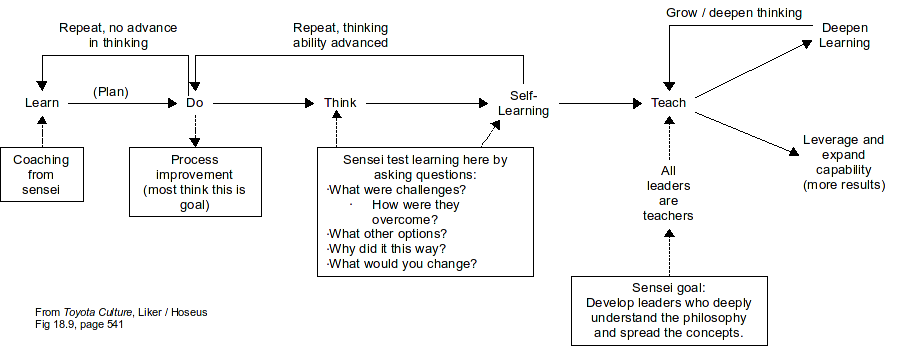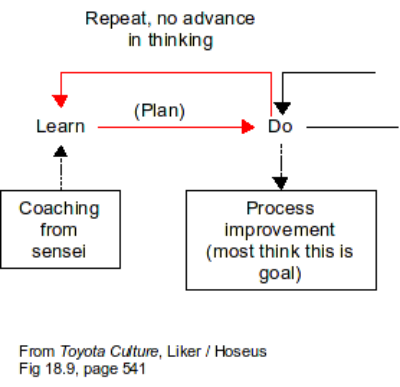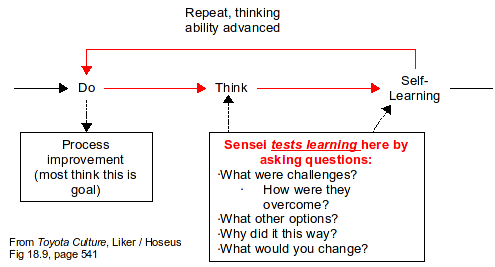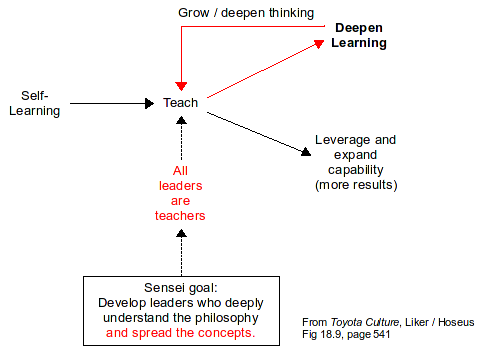The Lean Enterprise Institute has recently published Kaizen Express , an overview of the classic characteristics of “lean manufacturing” and, by implication, the Toyota Production System. As I set out to review the book, I found myself heading in two directions.
, an overview of the classic characteristics of “lean manufacturing” and, by implication, the Toyota Production System. As I set out to review the book, I found myself heading in two directions.
One is the content of the book itself.
Over the years, there have been a slew of books with similar tables of contents that describe the various mechanics and mechanisms observed in the Toyota Production System.
The first really comprehensive reference in English was Productivity Press’s translation of Hirano’s JIT Implementation Manual . (Originally a two volume set priced at $900, it appears it is about to be published in a second edition for around $200. I have not seen the second edition.) Back in the early and mid 1980’s, Hirano was about the only comprehensive reference out there. At Boeing we had internal-use reproduction rights, and many of us poured over those volumes, parsing every word.
. (Originally a two volume set priced at $900, it appears it is about to be published in a second edition for around $200. I have not seen the second edition.) Back in the early and mid 1980’s, Hirano was about the only comprehensive reference out there. At Boeing we had internal-use reproduction rights, and many of us poured over those volumes, parsing every word.
Kiyoshi Suzuki’s New Manufacturing Challenge (1987) was the book we gave out to all of our suppliers. It, too, provides a pretty good overview of most of the tools and techniques. It is a good basic reference, and I still believe it really takes about three years for a practitioner to outgrow it.
(1987) was the book we gave out to all of our suppliers. It, too, provides a pretty good overview of most of the tools and techniques. It is a good basic reference, and I still believe it really takes about three years for a practitioner to outgrow it.
At a more technical level, we have had Toyota Production System: An Integrated Approach to Just-In-Time by Yusuhiro Monden. This book goes into more depth from a system engineering standpoint, and focuses mostly on “Toyota’s production system” vs. a more generic approach.
by Yusuhiro Monden. This book goes into more depth from a system engineering standpoint, and focuses mostly on “Toyota’s production system” vs. a more generic approach.
These three titles are by no means the only ones. A couple of feet of my own bookshelf is occupied with books covering the same basic topics. I only mention these three only because they have been my workhorse references, especially in the days when I was still putting together my own mental models.
Kaizen Express is well at home with this family. It is a solid overview of the tools and techniques that generally characterize “lean manufacturing” and I can quibble with nothing that is in the book.
is well at home with this family. It is a solid overview of the tools and techniques that generally characterize “lean manufacturing” and I can quibble with nothing that is in the book.
The presentation itself harks back to the days when all of the decent references came out of Japan. It is a bilingual book, written in Japanese language and graphic style with English translation along side.
On a sidebar note: As a practitioner, dealing with shop floor people and their sensibilities and values, I would rather use a reference that didn’t come across as so foreign. While I fully appreciate that the Japanese vocabulary is a solidly embedded part of Toyota’s culture, that is not the case elsewhere, and some Toyota-trained practitioners would do well to keep that in mind. The concepts are difficult enough to get across without having to overcome language resistance. Add to that the unfortunate truth that many countries, especially in Asia, still have vivid cultural memories of a far more malevolent Japan, and the resistance just increases. I would not give a copy of this book out in China or Korea, for example. There are others which serve the same purpose without bringing up unresolved issues. Memories and emotions run much longer and deeper in Asia than they do in the West.
All of those reservations aside, this book is a welcome review of familiar material.
Now, the second part. I want to go beyond the book itself, and look at its context. This becomes not so much a review of the book, but one person’s opinion (mine, to be sure) of the state of our communities understanding of the Toyota Production System itself.
The TPS is somewhat unique among all of the various “management systems” in the popular business press today in that it grew organically rather than being explicitly designed. Thus, rather than consult standard documents to learn about it, knowledge comes from research.
In the early days, through the late 1980’s, the topic of “JIT” or “Japanese manufacturing techniques” was a quiet, esoteric backwater of consultants and a few committed practitioners. We knew about Harley Davidson, and some of the other early adopters. Danaher was just getting started, and some of the household name early leaders were starting to gain meaningful experience and reputations. The knowledge base came from practitioners trying to make it work, rather than professional academics who are in the business of developing and testing rigorous theory.
In late 1990, everything changed. The Machine That Changed the World by Womack, Jones and Roos published the results of good, solid research from MIT and became a hot seller. It broke out of the practitioner’s technical corral, got the attention of mainline executives and managers, and introduced the buzzwords “lean production” (which later morphed into “lean manufacturing”) into the lexicon of everyday business.
by Womack, Jones and Roos published the results of good, solid research from MIT and became a hot seller. It broke out of the practitioner’s technical corral, got the attention of mainline executives and managers, and introduced the buzzwords “lean production” (which later morphed into “lean manufacturing”) into the lexicon of everyday business.
This was followed by Lean Thinking which profiled a number of these companies and put Shingijutsu on everyone’s radar.
which profiled a number of these companies and put Shingijutsu on everyone’s radar.
The Lean Enterprise Institute was founded shortly thereafter, and in the late 1990’s published Learning to See and introduced everyone to value stream mapping. This was the first of a series of workbooks designed to take the practitioner through the mechanics of implementing various aspects of the basic elements of modern manufacturing techniques.
and introduced everyone to value stream mapping. This was the first of a series of workbooks designed to take the practitioner through the mechanics of implementing various aspects of the basic elements of modern manufacturing techniques.
These workbooks were something new. Rather than the encyclopedic approach of a single book devoting short chapters to descriptions of the various tools, these workbooks went into much more depth on a single topic, such as materials distribution , creating a work cell
, creating a work cell , the basics of heijunka
, the basics of heijunka or mentoring someone through solving a problem
or mentoring someone through solving a problem .
.
In the background of all of this, “lean manufacturing” became the hot topic. Writers, consultants, managers were all talking about how to “get lean” and to “lean out” a business. Hundreds of books were published on the topic, a few of them good, many of them re-hashing old stuff in new ways, a few just using the buzzwords to sell bad information.
This explosion resulted in a lot of noise pollution. What had started as peer-reviewed academic research of the automobile industry turned into the “lean industry” – a crowded, bustling bazaar with everyone hawking and touting their “solutions.” This, by the way, included a mountain of junk academic research.
But there was also some really exceptional academic research, especially out of Harvard. While everyone was busy implementing the tools of lean – the things in the tables of contents of all of those books, the success rate was a far cry from the promise. I have experienced this myself a couple of times. But Steven Spear made it the topic of his 1999 groundbreaking PhD thesis at Harvard. Let me quote, and offer my interpretation, of a few key sentences from the abstract of his dissertation.
Researchers have established that Toyota enjoys advantages in cost, quality, lead-time, and flexibility when compared to its competitors in automotive assembly.
There is no doubt here. It’s why we are all reading this stuff in the first place! And while there was considerable anecdotal evidence before that, The Machine That Changed the World offered up a solid base of good research to confirm what everybody was thinking.
offered up a solid base of good research to confirm what everybody was thinking.
Differences in generating value have been attributed to differences between the Toyota Production System (“TPS”) and alternative management systems. Distinctive tools and practices have been associated with TPS.
Those “tools and practices” are what are covered in the classic books I cited earlier. They are also what is covered in Kaizen Express if not by industry in general, certainly by the community of experts.
if not by industry in general, certainly by the community of experts.
However, evidence suggests that merely copying these [tools and practices] does not generate the performance advantages enjoyed by Toyota. This has prompted several questions … [including] … why is it so difficult to imitate?
So we (the community of experts) were happily out the there doing the stuff that was in the books, teaching the basics, trying to implement them, and finding it generally difficult to get a lot of traction once the initial novelty wears off.
Meanwhile, the noisy bazaar continued to churn out more and more “solutions” aimed at the “gaps in lean manufacturing.”
“Lean looks at waste, but doesn’t address variation…” so “Sigma” was spliced in. Yet Toyota obsesses on stability and eliminating variation at levels we cannot even fathom.
“We need someone to implement quality in our lean company.” Hello? How can you leave out quality? Yet in our efforts to implement flow and reduce inventory, we did it all of the time!
We try to bring kaizen into administrative and creative process flows – well enough, but upon finding that the “tools and techniques” need to be adjusted somewhat, people draw the conclusion that there is more to it.
All of these things, over the last ten or fifteen years seemed to make things very complex indeed.
So we go back to the basics.
I agree with the principle. But we need to discuss exactly what the basics are.
The second paragraph of Steven Spear’s abstract is pretty clear:
… the tools and practices that have received attention are not fundamental to TPS.
(emphasis added)
Then he brings up things that the rest of us never talk about:
… the … Rules-In-Use promote distinctive organizational features. These are nested, modular [organizational] structure; frequent, finely grained self-diagnostics; and frequent, structured, directed problem solving that is the primary mechanism for training and process improvement.
(emphasis added) (For explanation of what Spear means by “Rules-In-Use” read the dissertation itself, or Decoding the DNA of the Toyota Production System , which is the HBR summary of his conclusions. Personally, I “got it” a lot better from the dissertation, but then he has 465 pages to make his points vs. 10 pages in the article.)
, which is the HBR summary of his conclusions. Personally, I “got it” a lot better from the dissertation, but then he has 465 pages to make his points vs. 10 pages in the article.)
What has all of this got to do with the little green book, Kaizen Express ?
?
I think it is a great book, for 1991.
But this is 2009. So while Kaizen Express is a welcome refresher of the mechanics, those mechanics are, according to the current standing theory, built upon a foundation of something that Kaizen Express , and for that matter, the LEI has not, to date, addressed. What is missing, in my view, is how the tools and practices outlined in Kaizen Express
, and for that matter, the LEI has not, to date, addressed. What is missing, in my view, is how the tools and practices outlined in Kaizen Express and its predecessors actually drive daily continuous improvement that engages every team member in the process.
and its predecessors actually drive daily continuous improvement that engages every team member in the process.
Anyone out there is perfectly welcome to refute Spear’s research and make a compelling case that “the fundamentals” are, indeed, the things addressed in Kaizen Express. But to do so means bringing credible peer-reviewed, published research to the table. It means building a compelling case of documented observations that contradict Spear’s theory. Anything else is simply conjecture.
My challenge to the Lean Enterprise Institute: Your organization is unique. It emerged from the world of academia with very solid credentials, with a great mission to carry this message to the non-academic world. Because of its academic origins, LEI has a real opportunity to be the bridge between the cutting-edge understanding coming out of these top-flight research institutions and translate it into practical things the rest of us can put to use. Extend your charter to taking PhD words like “nested modular structure” and “frequent finely grained self-diagnostics” and giving the daily practitioners some workbooks that lay out how to do it.
Kaizen Express is a great little book.
is a great little book.
LEI can do better, though, than to re-publish material that has been out there since 1988.



